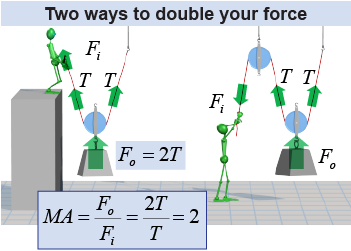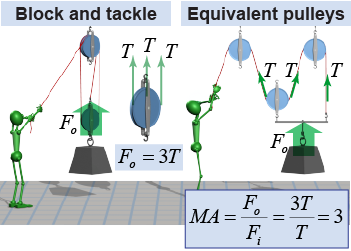|
A single pulley has a mechanical advantage of one because the input and output forces are equal. Combinations of pulleys are used together to achieve mechanical advantages different from one. Modern elevator drives often use pulleys and cables to create mechanical advantage as high as 15. 
|
 To create a mechanical advantage pulleys must be arranged so that the load is supported by more than one strand of the same rope. Since the tension in a rope is the same everywhere, two strands of the same rope supporting a load means that the tension force is applied to the load twice. The diagram on the right shows two different ways to use pulleys so that the output force is twice the input force. In both cases, notice how the load is supported by two strands of the same rope—each applying tension T.
To create a mechanical advantage pulleys must be arranged so that the load is supported by more than one strand of the same rope. Since the tension in a rope is the same everywhere, two strands of the same rope supporting a load means that the tension force is applied to the load twice. The diagram on the right shows two different ways to use pulleys so that the output force is twice the input force. In both cases, notice how the load is supported by two strands of the same rope—each applying tension T. 
|
 The block and tackle is a compound machine using two or more pulleys to support a load from a single length of rope. With a block and tackle, it is possible to arrange three pulleys so that a single input force applied to the rope is applied three times to the load, creating a mechanical advantage of three. When analyzing the input and output forces in a block and tackle, the crucial step is to identify how many times the tension in the rope is applied to the load. The mechanical advantage of a block and tackle is equal to the number of rope tension forces directly supporting the load.
The block and tackle is a compound machine using two or more pulleys to support a load from a single length of rope. With a block and tackle, it is possible to arrange three pulleys so that a single input force applied to the rope is applied three times to the load, creating a mechanical advantage of three. When analyzing the input and output forces in a block and tackle, the crucial step is to identify how many times the tension in the rope is applied to the load. The mechanical advantage of a block and tackle is equal to the number of rope tension forces directly supporting the load. 
|
Energy (work) must be conserved and the block and tackle enables a tradeoff between force and distance that is similar to the tradeoff for levers. The block and tackle above has a mechanical advantage of three, which means that the output force is three times larger than the input force. But it also means that you have to pull the rope by three meters for every one meter you lift the load vertically upward. You do the same amount of work, whether you pull a load using one or three pulleys. With three pulleys, however, you must pull the rope three times as far—while exerting only one-third of the input force—when compared to using only one pulley. 
|
 What is the mechanical advantage of the block and tackle system in the illustration at right?
What is the mechanical advantage of the block and tackle system in the illustration at right? | Asked: | mechanical advantage MA | | Given: | four pulley system (as shown on right) | | Solution: | There are four strands of the same rope supporting the mass. (Can you identify each of them?) The mechanical advantage is therefore four. | | Answer: | MA = 4 | 
|

